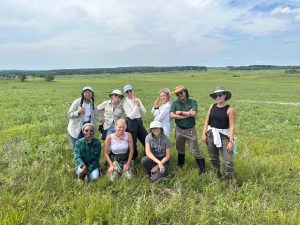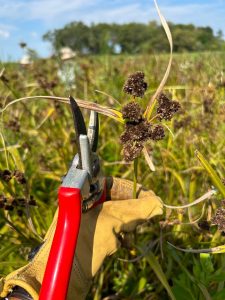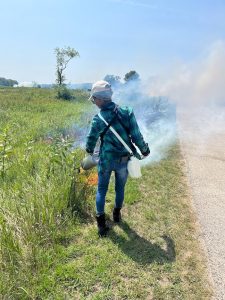
Environmental careers, nature art and Nachusa – CLIP Week 9!
by Katie Mikkelson
Monday July 31
We started our day with a career panel where we talked to professionals in the field of ecology. They told us about how they got into the field and what their current jobs entail. We gained a lot of insight into what careers in this field look like and how we can set ourselves up for success in our own future careers.
After our meetings, we went over to Small Waters Education in Harvard to learn about plant foraging with Jack and Judy Speer. We learned about (and tasted) a wide variety of plants, both native and non-native, including Lamb’s Quarter, Hibiscus flowers and countless others. Once we had gone over what is safe to eat, we went out on our own to forage before coming back together and sharing what we had gathered. While we were foraging we had a chance to see the bat that lives in a paw paw tree on the property, as well as a giant caterpillar that we believe was a polyphemus moth caterpillar.


Tuesday, Aug. 1
Throughout our internship, we’ve talked to many professionals in the field of conservation and many of them have asked us if we had gone on our Nachusa trip yet. We were very eager to find out what all the hype was about!



 On the trip we had a great time and learned a lot about what the people working at Nachusa do. We started by helping with some seed collection. We first collected bull rush and then fox sedge. After that, we got to see how they process seeds at Nachusa. They begin by putting the seeds into a large barrel where a special hose pumps air onto the seeds to ensure they won’t grow mold during the drying process. Then, the seeds are funneled into this special machine that helps remove the chaff and some of the other excess plant materials. Cleaned seeds are then put to the side in labeled barrels until use. Since Nachusa is so large most of the time it is unrealistic to spread all the seeds by hand, so they have this “vintage” farm instrument that gets pulled behind a tractor to drop seeds of varying sizes over a large area.
On the trip we had a great time and learned a lot about what the people working at Nachusa do. We started by helping with some seed collection. We first collected bull rush and then fox sedge. After that, we got to see how they process seeds at Nachusa. They begin by putting the seeds into a large barrel where a special hose pumps air onto the seeds to ensure they won’t grow mold during the drying process. Then, the seeds are funneled into this special machine that helps remove the chaff and some of the other excess plant materials. Cleaned seeds are then put to the side in labeled barrels until use. Since Nachusa is so large most of the time it is unrealistic to spread all the seeds by hand, so they have this “vintage” farm instrument that gets pulled behind a tractor to drop seeds of varying sizes over a large area.
When we were done learning about their seeding process, we went on a bison tour. We drove around until we found where the herd was hanging out, then we sat in the trucks (at a safe distance) and watched. There were lots of adorable calves!



 We also learned about the cattle corralling system that gets used once a year when they vaccinate, tag and count the bison. It was a system designed by Temple Grandin, known for her work in improving the way livestock is treated. Her system is designed to cause the least amount of stress to the animals possible. For example, high walls ensure that the cattle (in this case bison) are unable to see the people on the other side. It’s set up so the bison are funneled through the corral, entering in a zig-zag pattern as opposed to a straight line, which helps slow the animals down and avoid a stampede. Nachusa was such a beautiful and interesting place, and by the end, we could all understand why everyone was so excited for us to go on this trip.
We also learned about the cattle corralling system that gets used once a year when they vaccinate, tag and count the bison. It was a system designed by Temple Grandin, known for her work in improving the way livestock is treated. Her system is designed to cause the least amount of stress to the animals possible. For example, high walls ensure that the cattle (in this case bison) are unable to see the people on the other side. It’s set up so the bison are funneled through the corral, entering in a zig-zag pattern as opposed to a straight line, which helps slow the animals down and avoid a stampede. Nachusa was such a beautiful and interesting place, and by the end, we could all understand why everyone was so excited for us to go on this trip.
Wednesday, Aug. 2
The first part of the day was a workday at Crowley Oaks. We found quite a few toads that needed relocating and I even found a Polyphemus moth! In the afternoon we finished up our research project.
Thursday, Aug. 3
For the first part of the day, we did parsnip removal at Hennen. Then, we collected oval sedge at Yonder.
After that, we drove to the Save the Prairie Society to meet with the botanical illustrator Kathleen Marie Garness. We learned about what it’s like to be a botanical illustrator and also got practice using a dichotomous key to identify plants. We then sat outside around the Prairie Society building with a view of the beautiful prairie and practiced drawing some plants as the sun set. We also learned about the history of the particular prairie we were on. We discussed everything from the battle to keep the land from becoming residential areas to the history of the building that sits on the edge of the property. The building contains the remains of a historic house from the 1850s that was going to be torn down.



Friday, Aug. 4
Most of our day was spent with Melissa Grycan, who used to work at the TLC but now works for the Illinois Department of Natural Resources (IDNR) as a natural heritage biologist. We first collected Purple Coneflower seeds at Moraine Hills State Park. Once our seed collection bags were full, we got ready to help with a prescribed fire at Chain O’Lakes State Park. It was a growing season burn so it was less intense than it would’ve been in fall or spring (when most burns are done). Melissa told us that in her experience growing season burns have a much smaller impact on the wildlife in the area than burns during other times of the year. The amphibians and reptiles are able to move faster due to the warmer weather and the young birds are old enough to fly away. It was really cool to be a part of this burn. We gained some experience working on prescribed burns and got to practice our drip torch skills!



When we got back to Hennen, we had a resume workshop with Dean Eitel to wrap up the week.